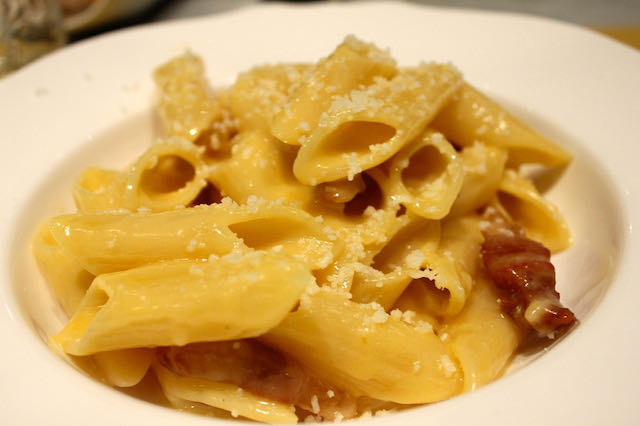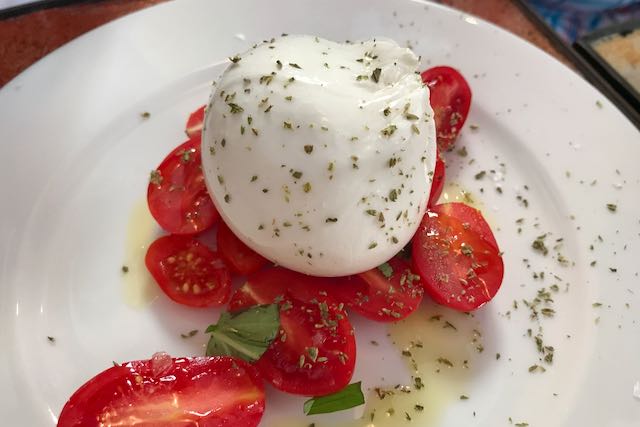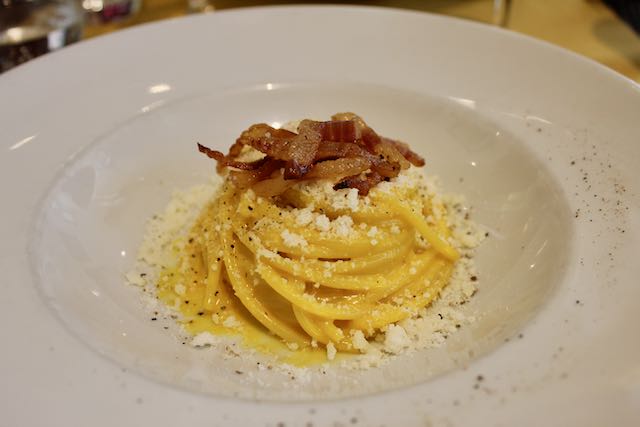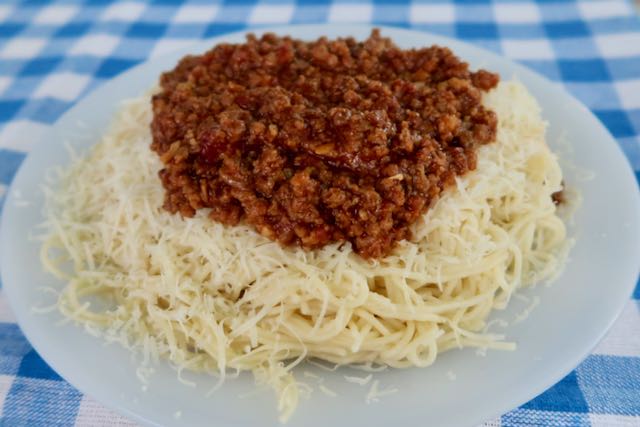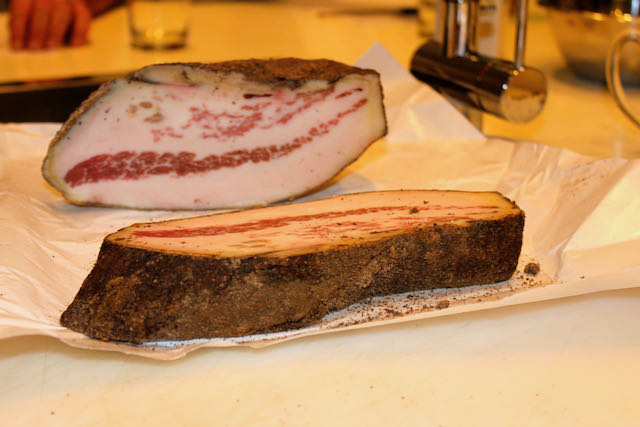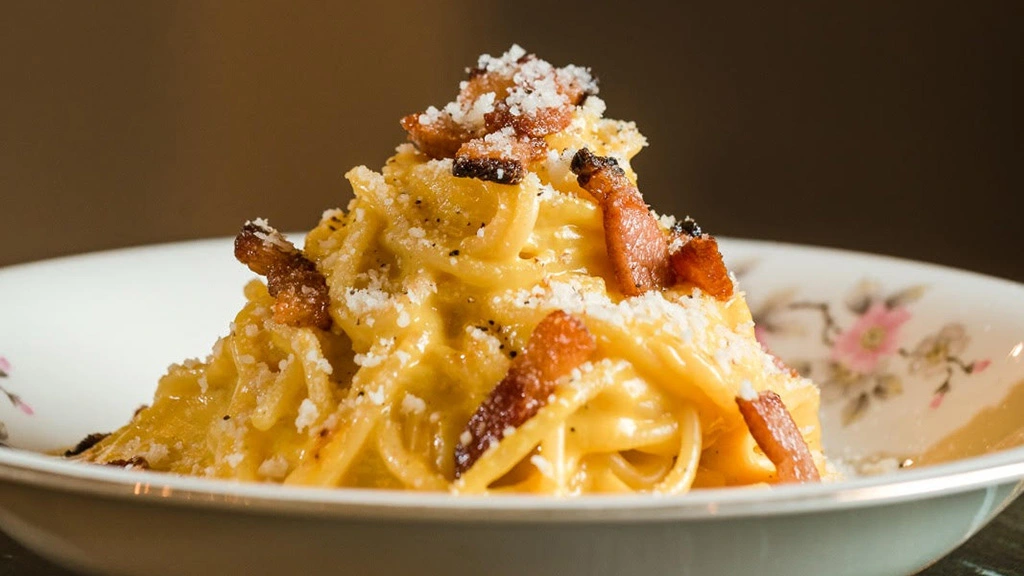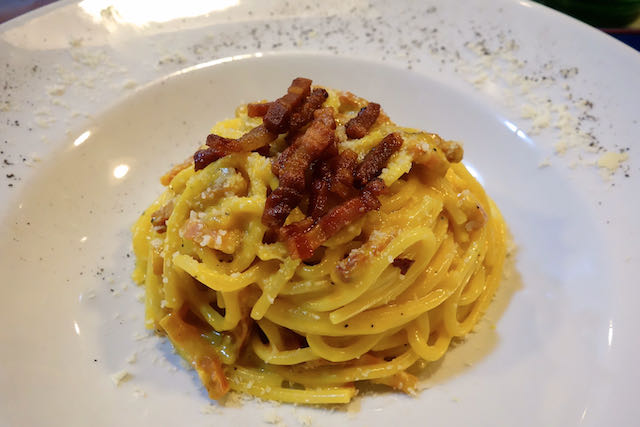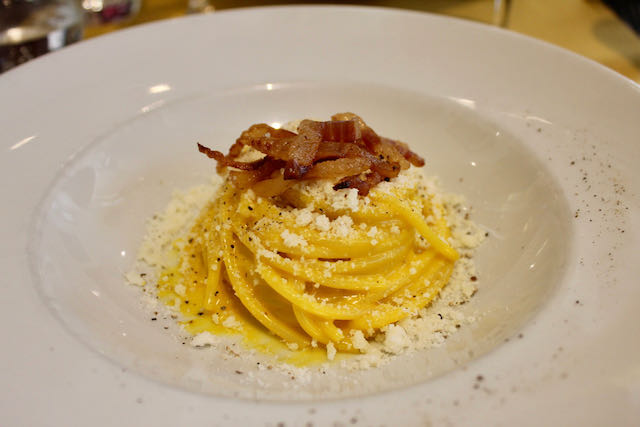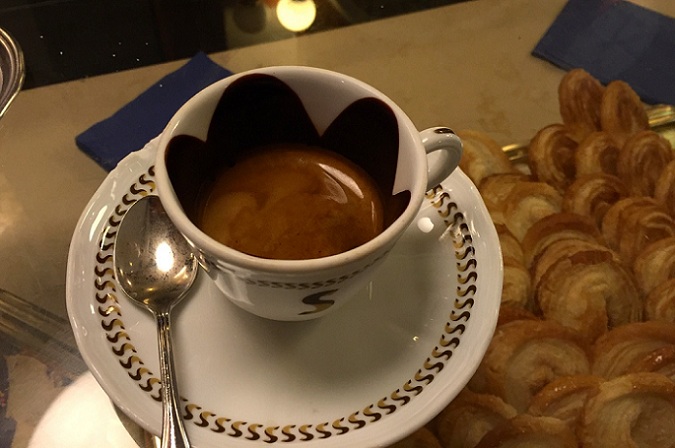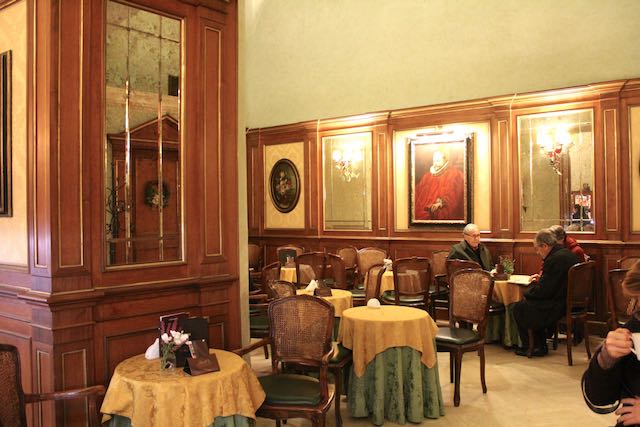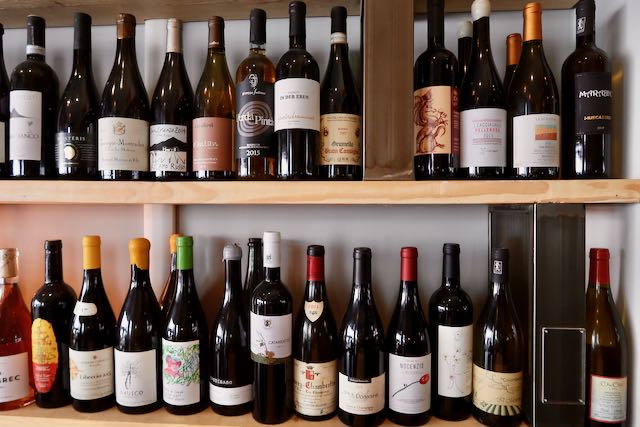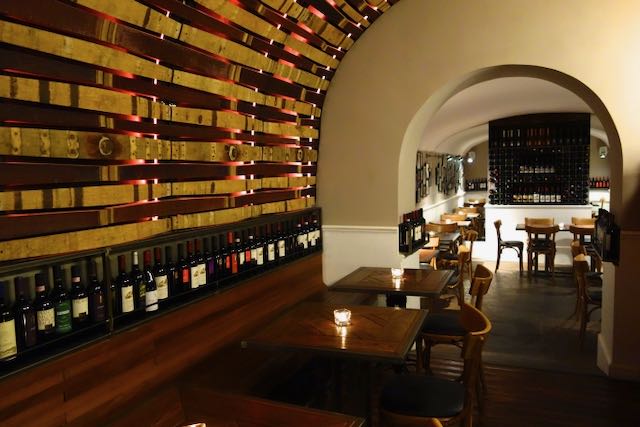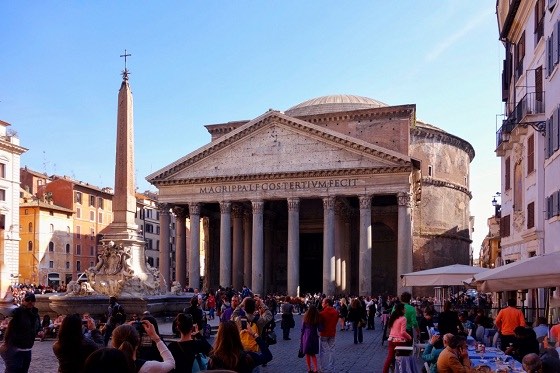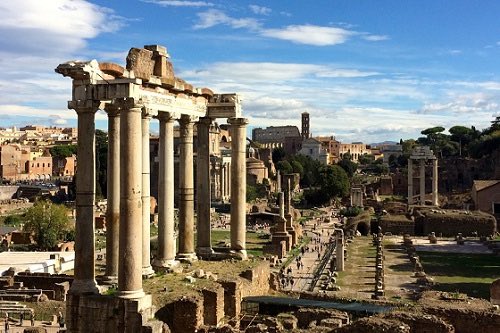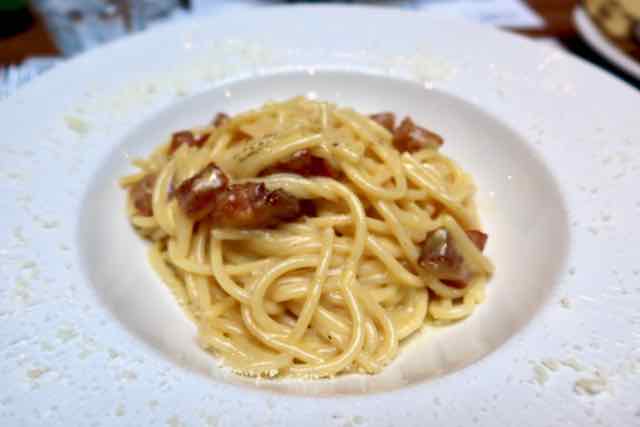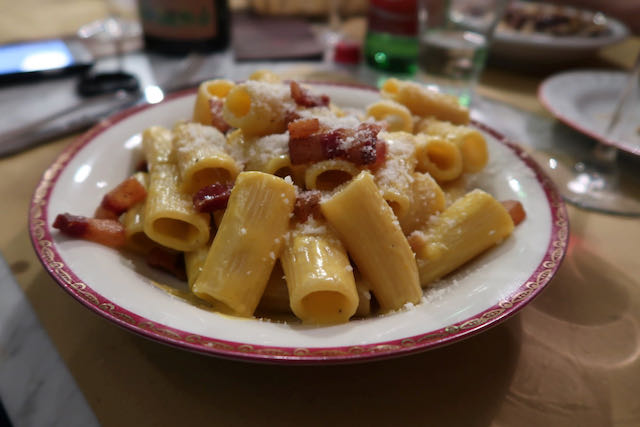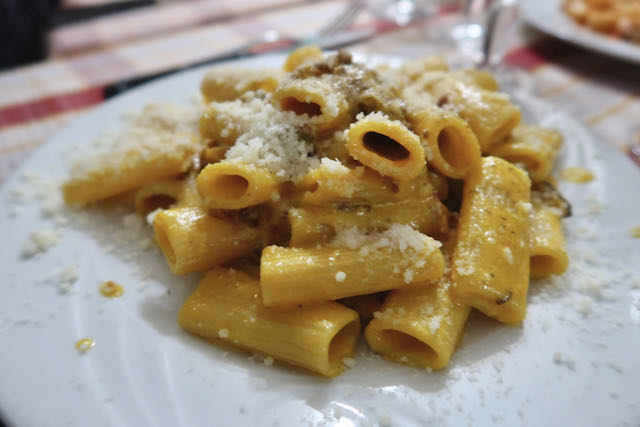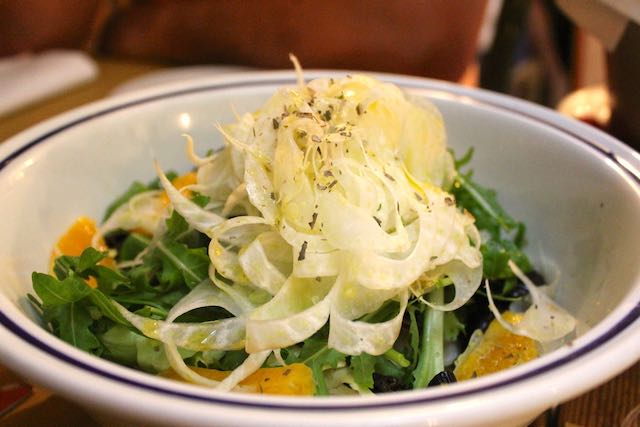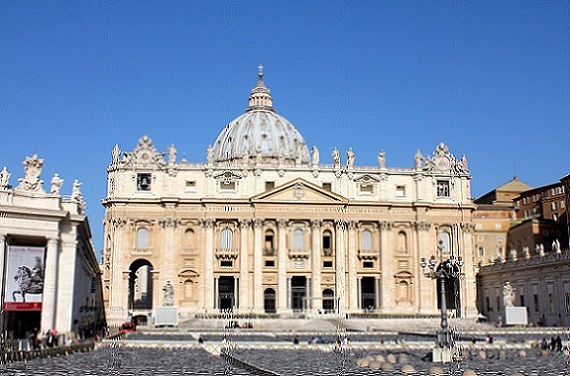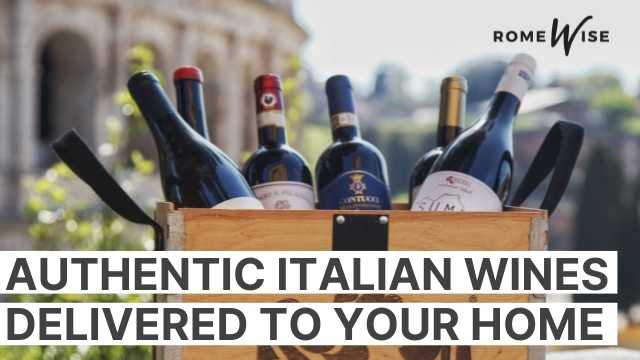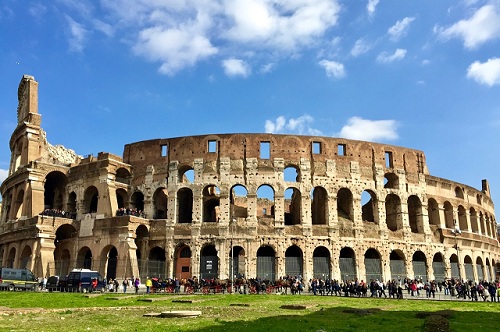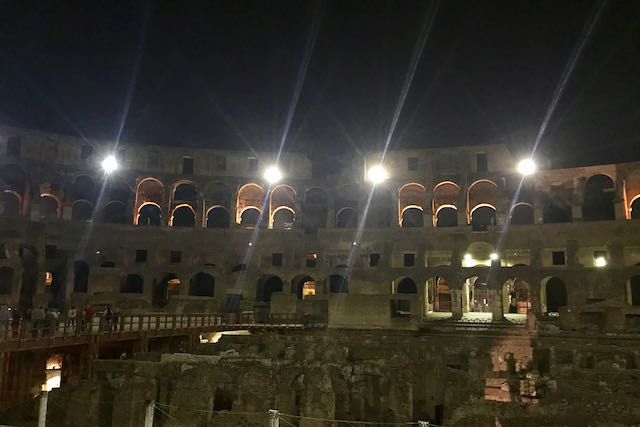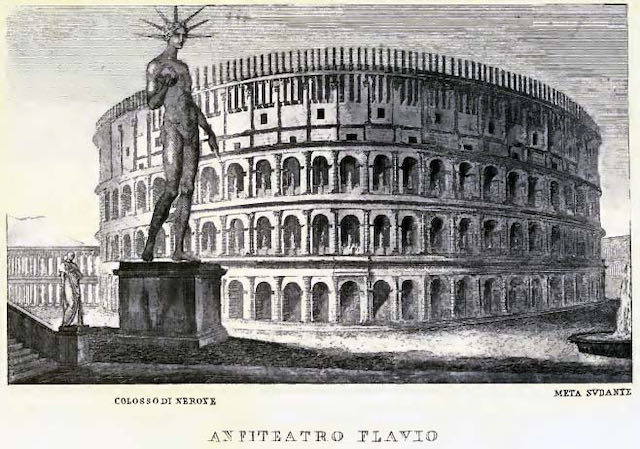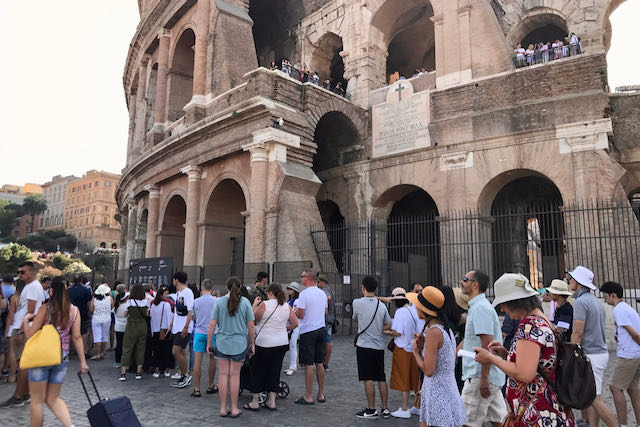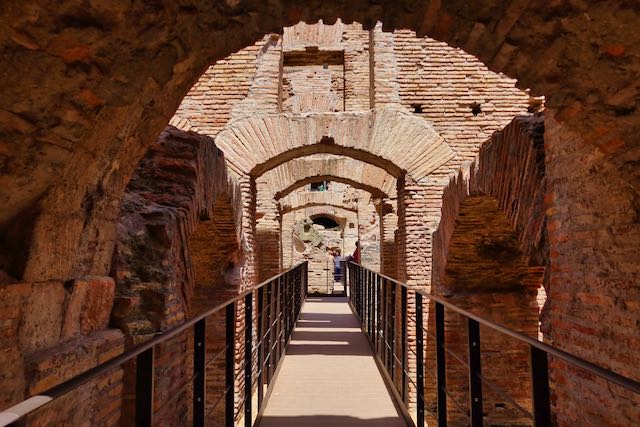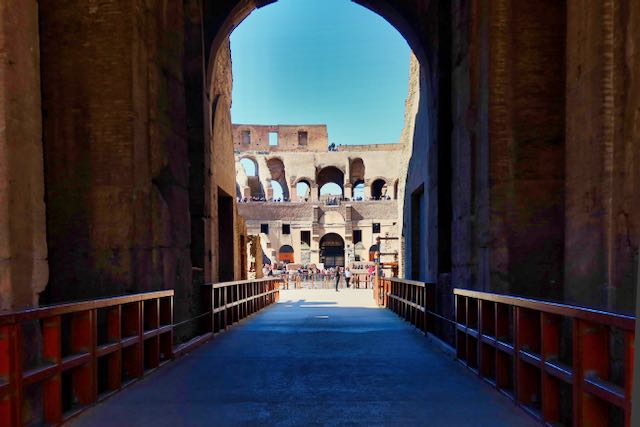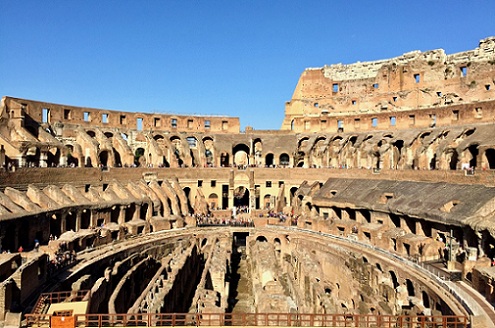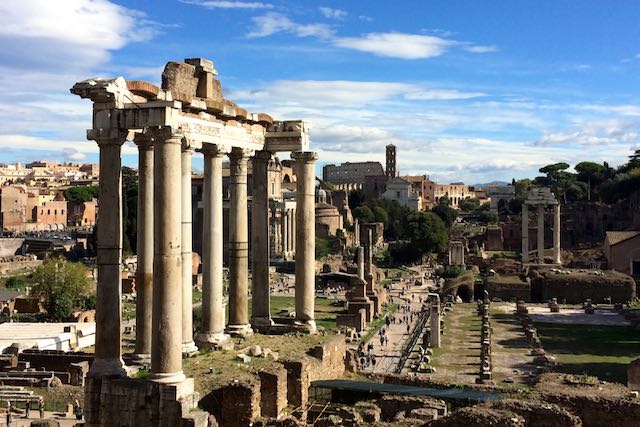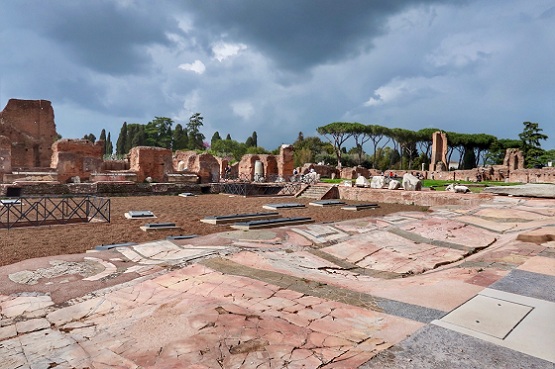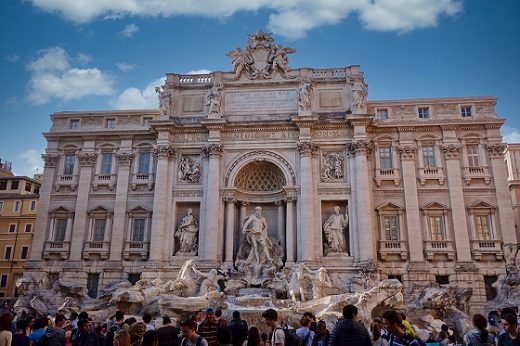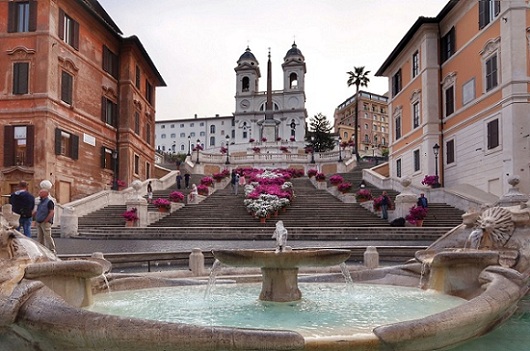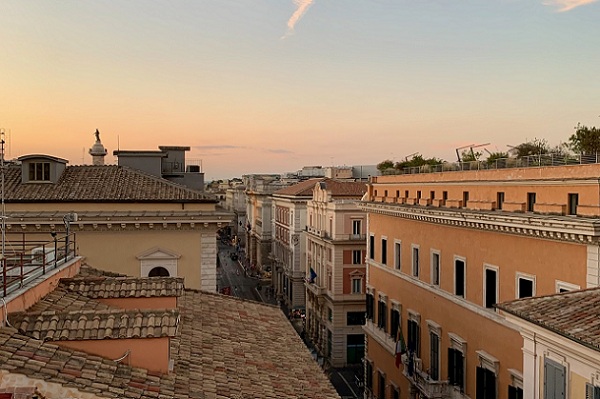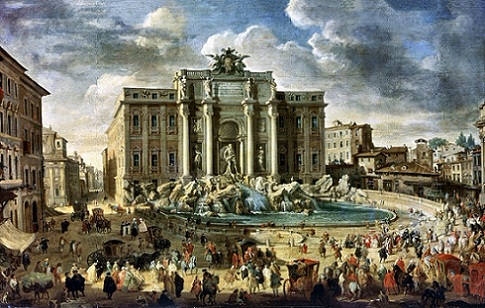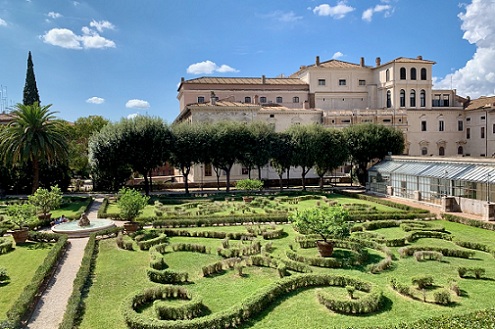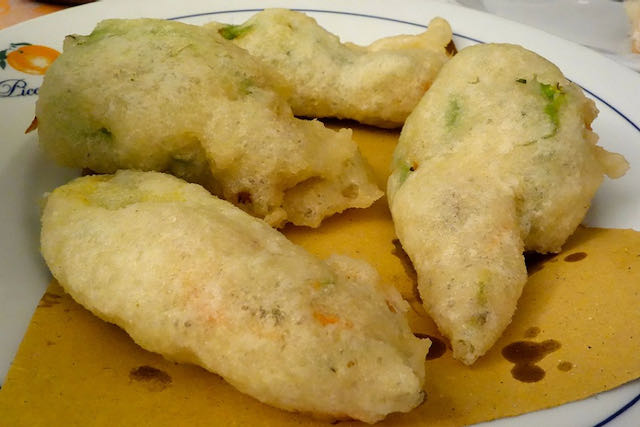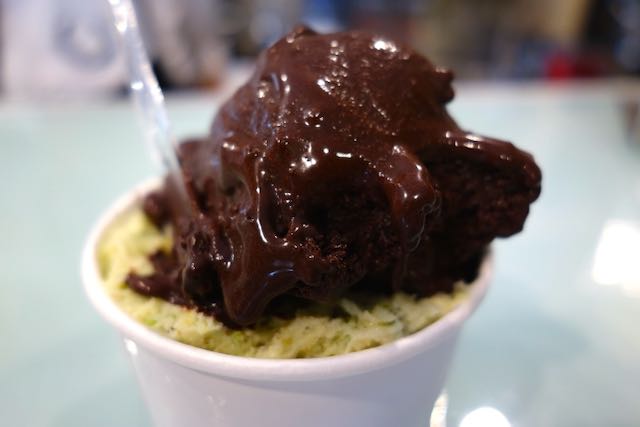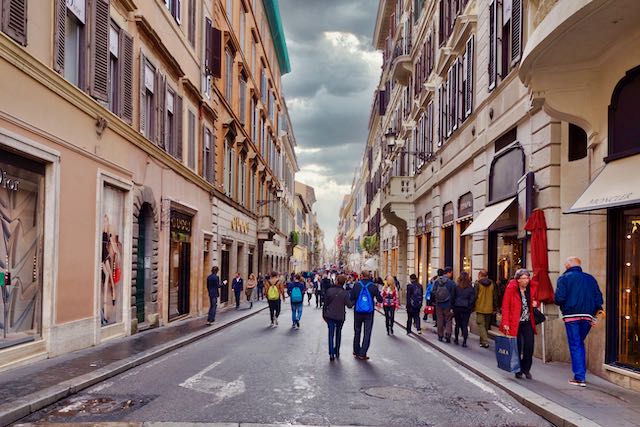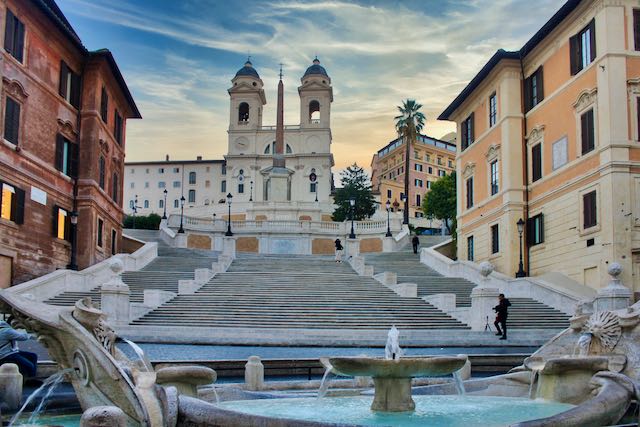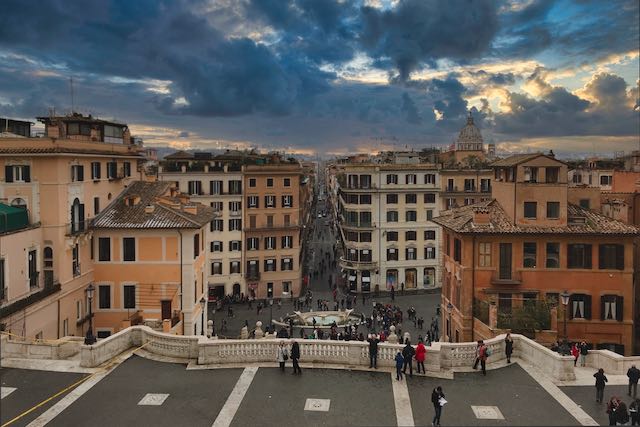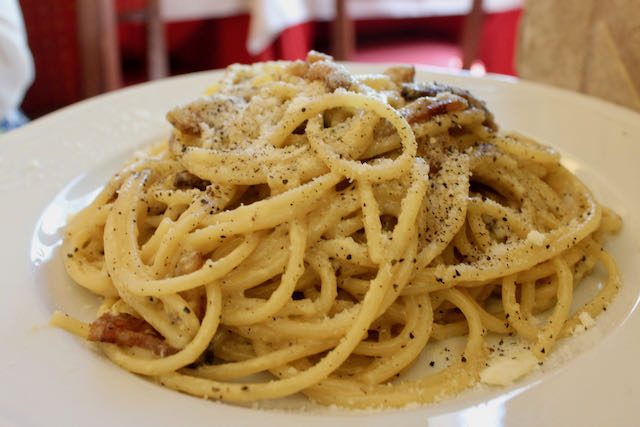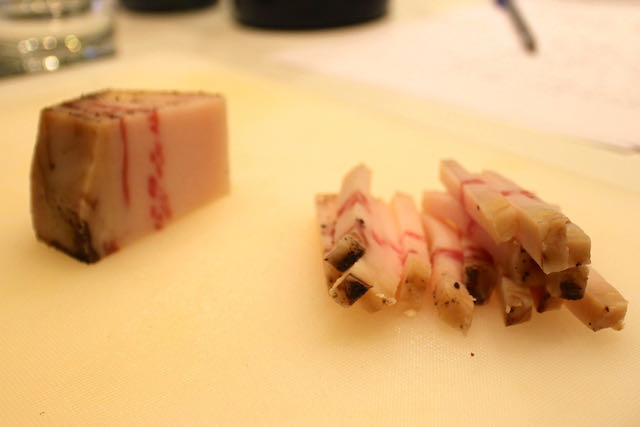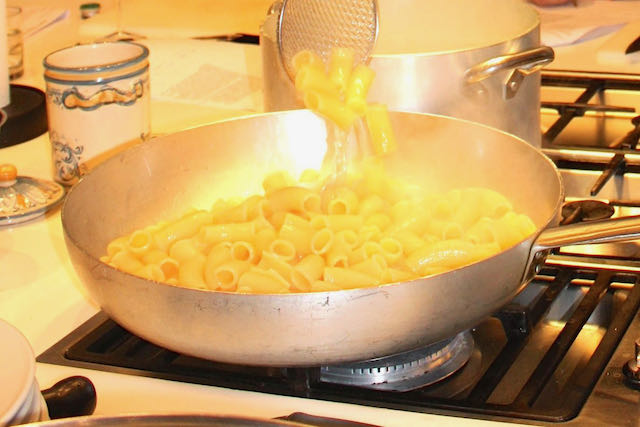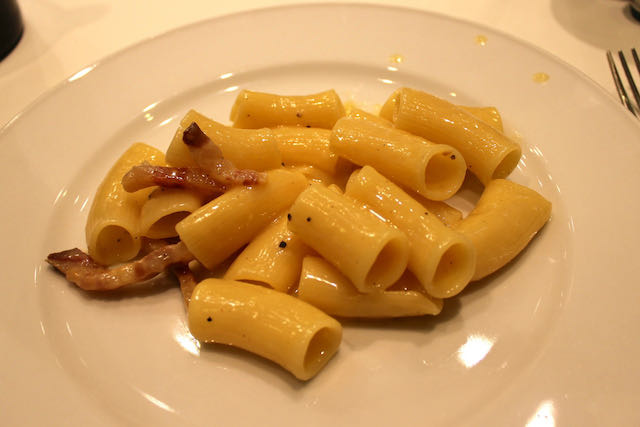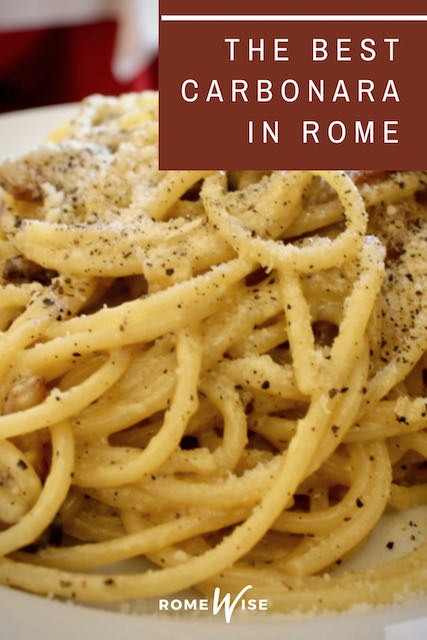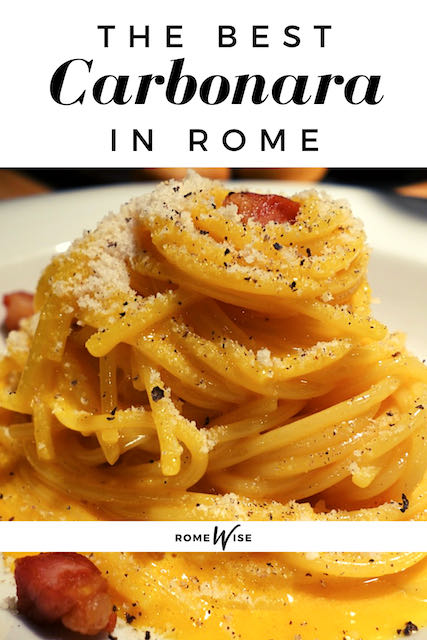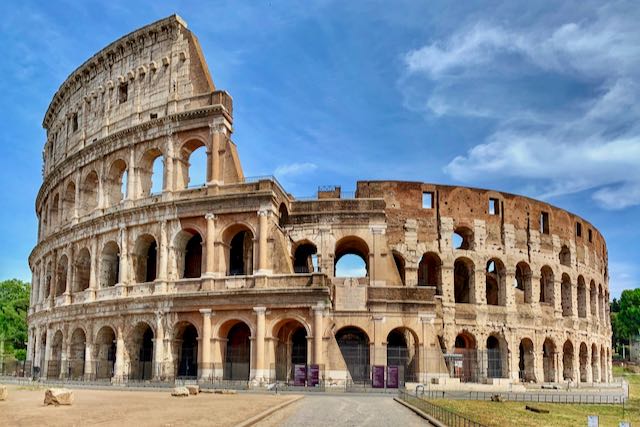- Sign up & get a FREE ebook Subscribe NOW!
- Romewise Home Page
- Where to Eat
- Carbonara in Rome
Best Carbonara in Rome
I am always on the lookout for the best carbonara in Rome.
(Yes, I know, it's a tough job but...)
Seriously, I do make it a point to run around Rome and taste-test all the traditional pasta dishes on a pretty regular basis.
There are enough variations to keep me from getting bored (now there's a concept.)
And there are so many restaurants to try, I still haven't gotten to them all yet!
But actually, finding the best traditional carbonara in Rome is not as easy as it sounds.
Carbonara in Rome - everything you need to know
Carbonara is one of the quintessential dishes of classic Roman Cuisine.
Here's what you should know:
- What is carbonara?
- Where are the best places to eat carbonara in Rome?
- Where can you get great carbonara near the tourist sites / neighborhoods?
- Looking for a good recipe for authentic carbonara?
What is carbonara?
I know what you're thinking - carbonara is too heavy, too fattening.
Well, not if you do it right!
Well, ok, maybe it's not not-fattening, but it's not heavy because it's not creamy.
It's not creamy because there is NO CREAM in carbonara in Rome!
Where it was invented by the way.
The origins of carbonara are not 100% clear.
Here are the two main theories:
1) Carbonara originated in Rome in World War II, when American GI's were in Rome, and food rations were short. So they improvised, using eggs, bacon and pasta to make one dish - voilà! Carbonara.
2) The "carbonai" or makers of charcoal, worked for months at a time outside the city, and camped, with few supplies, including bacon, cheese and eggs. So they whipped together a concoction which today became known as carbonara.
Neither of these stories has been validated...but it doesn't matter to me which is true, since, in Rome, you can always get the "original" version of the dish.
Which is to say, made with only the simplest of ingredients:
- fresh eggs (either the whole egg, or just egg yolk, depending on who you ask)
- guanciale (cured pork cheek, or jowls)
- pecorino Romano cheese
- high-quality dried pasta
See?
There is no cream in carbonara (when you get it in Rome.)
The cheese and egg, together with the inevitable pasta water that you add towards the end of the cooking procedure, amalgamate to make the whole thing "creamy."
So it's not a light dish per se, but may not be as heavy as you think.
For the recipe for carbonara, jump down the page.
For some reason, when it left Italy, many things have been added to carbonara, the most common being cream.
Also peas and onions.
So if you have avoided eating carbonara until now, do not miss trying it the Roman way.
What makes carbonara so delicious?
Believe it or not, as simple as this dish sounds to make, it's not always easy to find it prepared well (as with the other classic Roman pasta dishes, cacio e pepe and amatriciana.)
There are some important factors such as:
- The use of guanciale as opposed to pancetta (belly pork), or any other type of "bacon." The pork in carbonara should come from guanciale, or pork cheek jowls, to ensure its smoky, buttery flavour. (If you are trying to make this in a place where you can't easily get guanciale, go for the pancetta!)
- Egg yolks vs whole eggs - this one could be a bit more forgiving. There are excellent versions of carbonara with both. But when you only use the yolk, carbonara takes on a whole new flavour dimension.
- Not all pasta is created equal. With carbonara, you use dried pasta (as opposed to egg or fresh pasta.) Also, the pasta should be of high quality. As my cooking instructor once said, if you pay 10 Euros for a package of pasta, as opposed to only 2 Euros, it comes to what, about 2 Euros per portion of pasta? Isn't it worth it to have excellent pasta? So use good-quality pasta, preferably trafilata a bronzo (this means the pasta was put through a die made of bronze, which gives the pasta a texture that allows it to hold sauce better.) Now, which shape pasta to use? For Italians, the use of the correct pasta with a particular sauce is vitally important. For carbonara, spaghetti is just as good and as valid a choice as rigatoni (for sauce adherence of course.) My favourite is rigatoni. But I would never say no to an excellent spaghetti alla carbonara!
Where to eat the best carbonara in Rome
Best Carbonara in Rome - One Roman's point of view
So, I asked Alessandro, my Roman husband, "if you were going to go out for carbonara in Rome, where would you go?"
His answer - "I wouldn't."
And the reason for this, he explained, is that he grew up eating carbonara (and amatriciana, cacio e pepe) at home.
All. The. Time.
He said, "That's what papà used to make when mamma didn't feel like cooking." It's kind of like mac and cheese or meatloaf for Americans, something pedestrian, homey, more of a comfort food than something to GO OUT FOR.
With the boom in tourism in the last 20-30 years, and thanks to guidebooks and now social media, there seems to be a new-found interest in "Roman food and Roman trattorias."
And so, these basic pasta dishes, along with other peasanty Roman food, have all been taken to higher art forms, especially when they are at their simplest.
So please forgive me if this list is from my point of view and has nothing to do with a Roman chiming in.
His is just one man's point of view, but I get it.
As I said, I do a lot of taste-testing.
So far, I have found some pretty amazing carbonara in Rome.
Here are my top picks to date (I update this page as I continue with my taste-testing):
AGRODOLCE ROMA
Less than three minutes from the Trevi Fountain, tucked away on an unassuming side street you'll this relatively new restaurant in this area.
Agrodolce offers a traditional menu full of authentic options from Carbonara to fresh seafood.
Disclosure: Agrodolce is an official Romewise sponsor but as with everything we recommend we only endorse businesses, services and products that we have tried ourselves and whole-heartedly believe in.
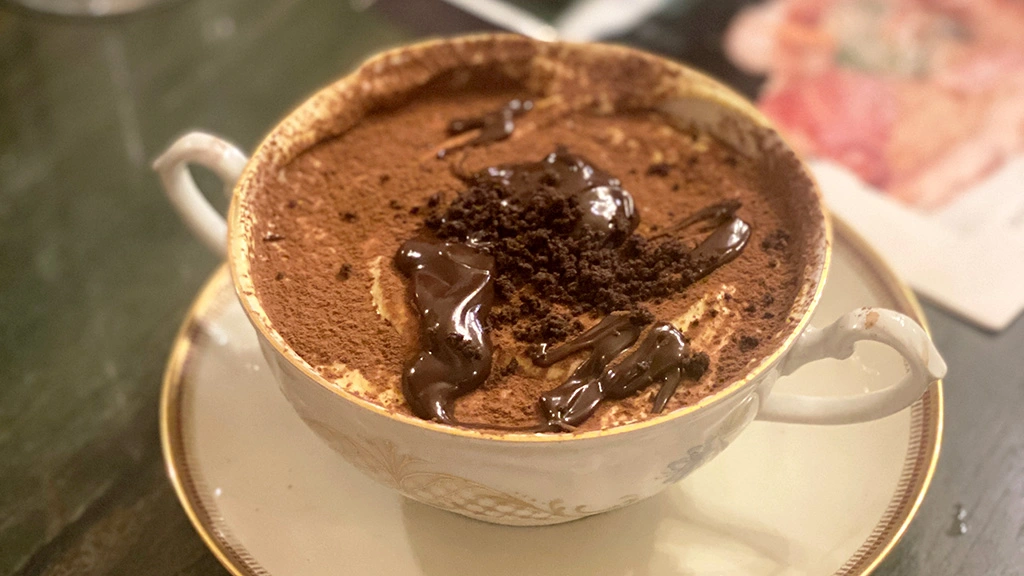 One of our favorite things on the menu at Agrodolce is their made-to-order tiramisu - you'll thank us later!
One of our favorite things on the menu at Agrodolce is their made-to-order tiramisu - you'll thank us later!We also love the decour and ambiance at Agrodolce; the owners have made a lot of efforts to make their restaurant standout with vintage tableware and other unique touches.
- Address: Piazza dei Crociferi, 25
- Phone: +39 06 678 8251
- Hours: Lunch: 12 - 4:30 PM | Dinner: 6 - 10:30 PM (11 PM Friday & Saturday)
- Reservations recommended for dinner (note code 'ROMEWISE' when booking for a free glass of prosecco 🥂)
- Opt for inside seating for a more intimate experience
Da Danilo
Da Danilo is one of the truly traditional Roman trattorias in Rome.
Everything is wonderful here, from the Roman artichokes to the carbonara (with perfectly crispy
guanciale) to the amatriciana.
They are so traditional in fact, they would not let my friend order a caffè macchiato after lunch (milk?? the horror! Espresso or nothing!)
- Address: Via Petrarca, 13
- Phone: +39 06 7720 0111
- Hours: Monday - Saturday: 12 - 11 PM | Sunday closed
- Esquilino neighborhood
- Reservations essential
- No outdoor seating
🍝 A Pasta Lover’s Dream 🍝
Perfect for pasta lovers!
Dive into Italian culture by learning pasta-making secrets, and enjoying the delicious results with these delightful culinary experiences.
Grappolo D'Oro
Grappolo d'Oro is a Slow Food restaurant.
That should tell you right there you will get excellent Roman food.
Look at that eggy sauce.
Look at all that gorgeous fresh ground pepper.
See that lovely grated pecorino on top?
And how firm that pasta is?
Great carbonara.
Trust me.
- Address: Piazza della Cancelleria, 80
- Phone: +39 06 689 7080
- Near Campo dei Fiori
- Hours: Monday - Sunday: 12 - 11 PM
- Reservations strongly suggested
- Outdoor seating
Rimessa Roscioli
Rimessa Roscioli is my go-to wine bar and it's long since become one of my favorite spots for dining as well.
They use the same ingredients as their related restaurant, the more famous Roscioli.
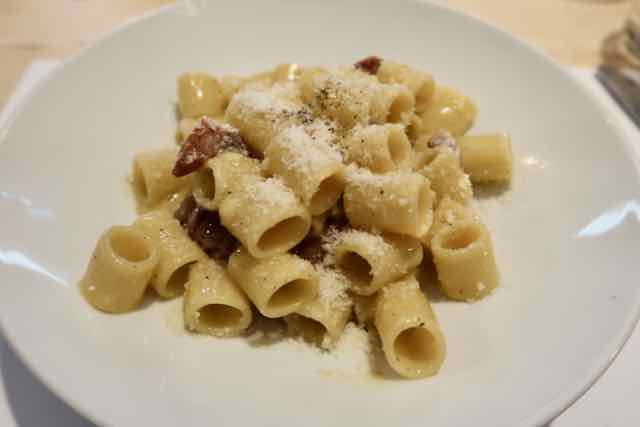 Mezze maniche alla carbonara at Rimessa Roscioli.
Mezze maniche alla carbonara at Rimessa Roscioli.But somehow, the chefs at Rimessa have found the way to make the Roman pastas like carbonara to perfection.
Carbonara is not always on the menu here but when it is, I get it!
- Address: Via del Conservatorio, 58
- Phone: +39 066 880 3914
- Hours: Monday - Friday: 5 - 11 PM | Saturday - Sunday: 12 - 2 PM, 5 - 11 PM
- Near Campo dei Fiori and the Jewish Ghetto
- Outdoor seating
- Reservations essential
Piatto Romano
Testaccio neighborhood is well-known among Romans as having plenty of truly Roman places to eat.
And Piatto Romano is no exception.
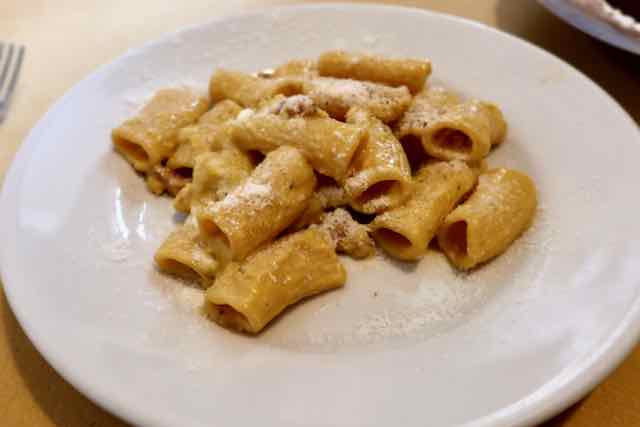 This is a half-portion of rigatoni carbonara at Piatto Romano. I love sharing! And this was more than plenty - delicious!
This is a half-portion of rigatoni carbonara at Piatto Romano. I love sharing! And this was more than plenty - delicious!You might even say, Piatto Romano is the epitome of Roman cuisine in this neighborhood.
You'll find plenty of truly Roman offal delicacies like tripe and coratella, but if that's not your thing, tuck into any of their pastas, like carbonara, and you will be transported.
- Address: Via Giovanni Battista Bodoni, 62
- Phone: 06 6401 4447
- Hours: Monday - Saturday: 12:45 - 3 PM, 7:45 - 11:30 PM | Sunday closed
- Testaccio
- Outdoor seating
- Reservations recommended
Trattoria Pennestri
Trattoria Pennestri is a Roman favorite.
They have plenty of typical Roman dishes and also a few more innovative ones.
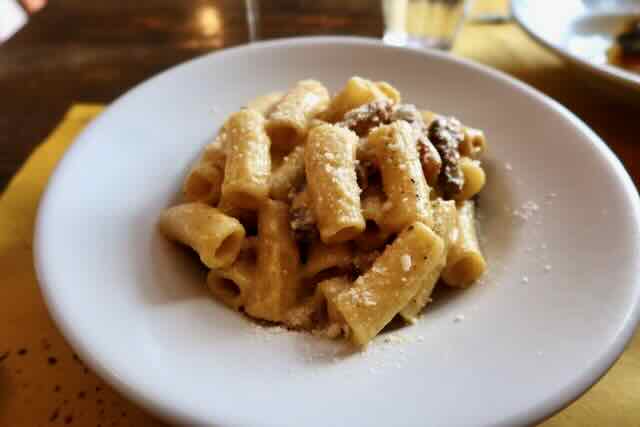 I love the rigatoni carbonara at Trattoria Pennestri.
I love the rigatoni carbonara at Trattoria Pennestri.Their rigatoni carbonara is sublime and worth going out of your way for.
- Address: Via Giovanni da Empoli, 5
- Phone: 06 574 2418
- Hours: Tuesday - Thursday: 7 PM - 11 PM | Friday - Sunday: 12 - 3 PM, 7 - 11 PM | Monday closed
- Near Testaccio
- No outdoor seating
- Reservations essential
Luciano
Can you imagine a Michelin star chef creating carbonara so delicious it literally melts in your mouth?
Luciano Monosilio got his star at the young age of 27 and worked in several high-end restaurants before opening his eponymous Luciano.
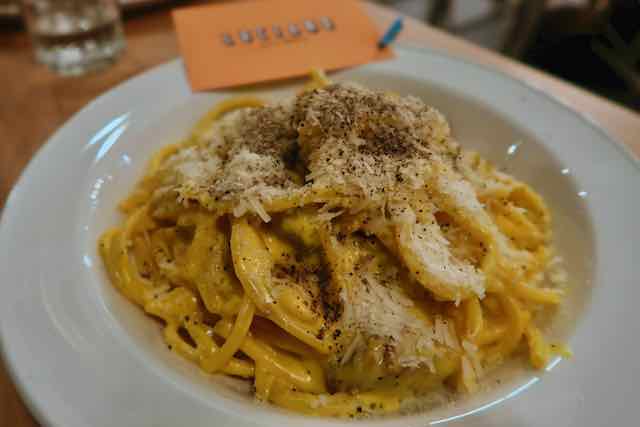 Carbonara at Luciano - what happens when a Michelin-star chef takes the helm.
Carbonara at Luciano - what happens when a Michelin-star chef takes the helm.The menu here is pretty vegetarian unfriendly, but if you are a carbonara lover, don't miss this spot and Lucian's signature dish!
Great spot for a romantic meal as well.
- Address: Website | Piazza del Teatro di Pompeo, 18
- Phone: 06 5153 1465
- Hours: Monday - Sunday: 12 - 3PM, 7 - 11PM
- Campo dei Fiori neighborhood
- Outdoor seating
- Reservations recommended
Pizzeria Emma
Why does a pizzeria have such good carbonara?
Because it's Emma.
Because every single thing they make is fabulous.
Not fancy or Michelin-quality.
Just consistently wonderful.
My sense after eating here A LOT (I've lost track and I've pretty much tried most things on the menu), is that the thing they care about first and foremost are the ingredients.
And that is of course one of the most important factors in getting it right.
But besides superb quality ingredients, they really do make fantastic pastas.
Many people go straight for their pizza (which is divine too), but I suggest you let them wow you with their pasta as well.
And, although this is not traditional, they DO also offer a "vegetarian carbonara."
- Address: Via del Monte della Farina, 28
- Phone: +39 06 6476 0475
- Hours: Monday - Friday: 12:30 - 3:30 PM, 7 - 11:30 PM | Saturday - Sunday: 12:30 - 3:30 PM
- Near Campo dei Fiori
- Reservations essential
- Covered outdoor seating
Santo Palato
Santo Palato may be a relative new kid on the block as Roman restaurants go, but it sure came in with a bang.
With talented, young chef Sarah Cicolini at the helm, the restaurant has become a favorite with Romans, foodies, and food writers alike.
If you are a fan of the most basic of Roman cuisine, you will have come to the right place.
Since the focus here is pretty heavy on meat and offal, this is not an ideal spot for vegetarians (although you can manage with vegetables and tonnarelli cacio e pepe).
And if you are a carbonara lover like me, well, this is serious carbonara.
I managed to eat that whole dish, which is rare for me.
- Address: Piazza Tarquinia, 4a/b
- Phone: +39 06 7720 7354
- In San Giovanni area
- Hours: Monday - Sunday: 12:30 - 3 PM, 7:30 - 11:30 PM
- Reservations a must
- No outdoor seating available
Lo Scopettaro
Even if it's on the perimeter of the once-working-class neighborhood of Testaccio, Lo Scopettaro counts itself as a typical Roman trattoria where you will find all the classic Roman dishes - offal (tripe, intestines, etc); artichokes (in season); broccoli and skate soup (only on Fridays!); and of course, some of the best carbonara in Rome.
Their meats are a little heavy (that is what Roman secondi are often like anyway), but I'd get any of their pastas, anytime.
And they have a cozy, rustic interior.
Even the lower-level (basement) seating is spacious and comfortable.
- Address: Lungotevere Testaccio, 7
- Phone: +39 06 575 7912 | +39 06 574 2408
- Hours: Monday - Sunday: 12:30 - 2:45 PM, 7:30 - 10:45 PM
- Reservations essential
- No outdoor seating
Roscioli
I hesitated about keeping Roscioli in my list of the best carbonara in Rome.
Why?
Because it's already so popular and written about.
But the carbonara at Roscioli is a classic.
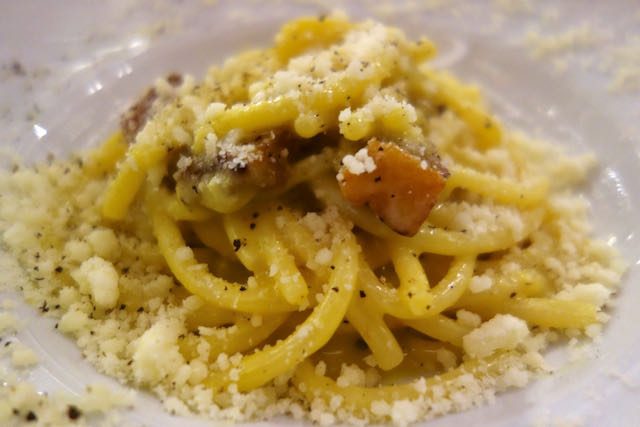 The pasta alla carbonara is one of the most popular dishes at the very popular Roscioli. But don't let that deter you!
The pasta alla carbonara is one of the most popular dishes at the very popular Roscioli. But don't let that deter you!So if you go, make sure you book in advance, and be prepared to literally rub elbows with your fellow tourists.
- Address: Via dei Giubbonari, 21/22
- Phone: +39 06 687 5287
- Hours: Monday - Sunday: 12:30 - 3:30 PM, 7 - 11:30 PM
- Near Campo dei Fiori
- Reservations essential
- No outdoor seating
Ready to plan your trip?
Book your train
Planning to travel between cities in Italy and other parts of Europe?
Use Trainline to see all the different options available across the different rail companies.
Find your hotel
Find your perfect place to stay in Rome.
Use Booking.com to choose between hotels, guesthouses, and self-catering apartments in neighborhoods throughout the Eternal City.
Buy your TurboPass
Purchase the convenient Turbopass and visit all of Rome's top attractions including the Colosseum, Pantheon, and Vatican.
With one handy pass, it's all included.
L'Arcangelo
The food at L'Arcangelo is excellent, and the ambiance is fun, warm, and convivial but not too crazy.
The carbonara, while often cooked just 1 minute short of perfectly al dente, is sublime.
Aside from the classic carbonara dish, the rest of the menu is almost entirely NOT about typical Roman cuisine.
It's more of a slightly gourmet menu.
(Be prepared to spend upwards of 40€ per person for dinner, without wine.)
- Address: Via Giuseppe Gioacchino Belli 59
- Phone: +39 06 321 0992
- Not far from the Vatican Museums
- Hours: Monday - Saturday: 7:30 - 11:30 PM | Sunday closed
- Reservations essential
- No outdoor seating
Frankly if you go to any traditional Roman trattoria, you are going to find good, if not great carbonara.
And as you can imagine, there are hundreds, if not thousands of trattorias around Rome.
So you really should not have a hard time finding a proper carbonara in Rome.
Looking for real, authentic Italian wine back home?
Look no further!
The Roscioli Italian Wine Club delivers worldwide only the best organic Italian wines in collections curated by the experts at Roscioli in Rome.
Find out more from Lindsay Gabbard, co-founder of the Roscioli Italian Wine Club here:
Subscribe today and save 25€ on your first payment with code ROMEWISE - click here:
Best Carbonara in Rome near the sites and neighborhoods
If you are touring the below sites or neighborhoods, and want some excellent carbonara (or other Roman dishes), besides the places I listed above, try these spots:
Carbonara near the Vatican
- Velavodetto ai Quiriti - Piazza dei Quiriti, 4/5. Tel: 06 3600 0009
- Ostaria delle Commari - Via Santamaura, 23. Tel: 06 3972 9557
- Ragno d'Oro - Via Silla, 26. Tel: 06 321 2362
Visit my page where to eat near the Vatican for more places in general.
Carbonara near the Colosseum
- il Bocconcino - Via Ostilia, 23. Tel: 06 7707 9175
- i Clementini - Via di S. Giovanni in Laterano, 106. Tel: 06 4542 6395
- Osteria della Suburra - Via Urbana, 67. Tel: 06 486531
Visit my page where to eat near the Colosseum for more places in general.
All about the Rome Colosseum
Carbonara near the Trevi Fountain
- Hostaria Romana - Via del Boccaccio, 1. Tel: +39 06 474 5284
- il Falchetto - Via dei Montecatini, 12. Tel: 06 679 1160
- Piccolo Arancio - Vicolo Scanderbeg, 112. Tel: 06 678 6139
- Sora Lucia - Via Rasella, 138. Tel: +39 06 679 4078
Visit my page where to eat near the Trevi Fountain for more places in general.
Carbonara near the Pantheon and Piazza Navona
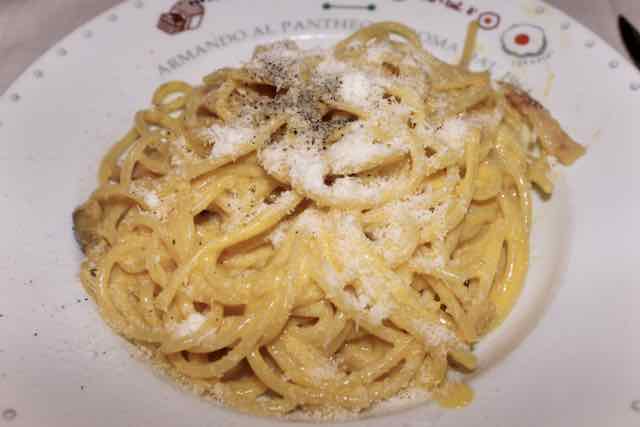 At Armando, carbonara is made the old-fashioned way, the guanciale is soft-cooked, with the fat left on each tasty morsel.
At Armando, carbonara is made the old-fashioned way, the guanciale is soft-cooked, with the fat left on each tasty morsel.In addition to some of my favorite places for carbonara, the area around the Pantheon and Piazza Navona is also fully of Roman trattorias.
You'll find excellent carbonara here:
- Del Sostegno
- Armando al Pantheon
- Trattoria Lilli
Visit my pages where to eat near the Pantheon and where to eat near Piazza Navona for more places in general.
Carbonara near the Spanish Steps
- Arancia D'Oro - Via di Monte d'Oro, 17. Tel: 06 686 5026
- Matricianella - Via del Leone, 4. Tel: 06 683 2100
- Osteria Barberini - Via della Purificazione, 21. Tel: 06 474 3325
Visit my page where to eat near the Spanish Steps for more places in general.
Carbonara in Trastevere
Trastevere is not a tourist site per se, although it is a wonderful neighborhood to stay in or visit.
And it's an area known for having a LOT of restaurants.
But good ones?
There are just a handful.
Here are three excellent spots to get carbonara in Trastevere:
- Checco Er Carettiere - Via Benedetta, 10. Tel: 06 581 7018
- Da Carlone - Via della Luce, 5. Tel: 06 580 0039
- La Gattabuia - Via del Porto, 1. Tel: 06 584813
- Da Teo - Piazza dei Ponziani, 7A. Tel: 06 581 8355
Visit my page about where to eat in Trastevere for more places to eat.
Carbonara In Testaccio
Testaccio is famous for having once been a working-class neighborhood, and site of Rome's most prominent slaughterhouse.
And because of that, the area is full of traditional Roman trattorias.
Here are a few where you can be sure to get excellent carbonara:
- Da Bucatino - Via Luca della Robbia, 84. Tel: 06 574 6886
- Antico Forno - Via Amerigo Vespucci, 28. Tel: 06 574 6280
- La Torricella - Via Evangelista Torricelli, 2/12. Tel: 06 574 6311
- Da Oio a Casa Mia - Via Galvani, 43. Tel: 06 578 2680
- Checchino - Via di Monte Testaccio, 30. Tel: 06 574 3816
Carbonara near Campo dei Fiori
Campo dei Fiori can be considered a tourist site (market) but also a neighborhood.
And while it's somewhat packed with a lot of mediocre tourist traps (I don't like that term but it does apply to this area in particular), there are a few authentic places in Campo dei Fiori where you will find quality Roman cuisine, including excellent carbonara:
- La Fiaschetta
- Antica Hostaria Romanesca
- Hostaria Farnese
Do you have a favorite place for carbonara in Rome?
Wondering why I didn't include them?
In some cases I might know who you are talking about.
But sorry, no.
I can't include them.
I don't promote places that treat non-locals terribly.
But as I said, if you go to any good traditional Roman trattoria, you will find good carbonara in Rome.
Recipe for Traditional Roman Pasta alla Carbonara
A little about making Roman pasta dishes
I take cooking classes in Rome with a Sicilian chef.
One of my classes was all about i primi romaneschi.
This means, "typical Roman first courses", which in this case is pasta.
Three of the most common are cacio e pepe, bucatini all'amatriciana and rigatoni alla carbonara.
The chef told us that every Roman has their way of making these dishes, and they are all "the right way."
And, there is no need to use salt or olive oil in any of them.
All use pecorino Romano cheese, which is plenty salty (and adds fat), and two use guanciale, or pork jowls, which are also fatty and salty.
You may use some salt in the pasta water, but not too much.
Would you like to take a cooking class while in Rome? There are a lot of great options!
Our chef said the success of any recipe is 80% due to the quality of the ingredients, 10% to the recipe and 10% to the chef.
So try to find guanciale if you can (not pancetta), excellent pasta like Verrigni (preferably trafilati al bronzo), and real pecorino romano cheese (not parmesan or other cheese.)
Disclosure: If you make a purchase through a link on this page, I may receive a small commission - at no extra cost to you. Thank you for supporting my site!
Ingredients
This recipe serves 6.
(Italian portion sizes are smaller than American portion sizes, so you may consider this recipe could serve 4 if you want larger portions.)
The original recipe uses metric measurements so I am providing rounded up/down measurements also in ounces if you prefer that.
- 600 grams (20 oz.) of rigatoni, trafilati al bronzo
- 300 grams (10 oz.) of aged guanciale
- 125 grams (4.5 oz.) of pecorino romano cheese
- 4 egg yolks (you can also opt for whole eggs if you prefer)
- 25 (1 oz.) grams of black peppercorns
- salt (only to add to the pasta water)
Method
Start heating the water for the pasta in a large pot.
Do not add salt.
Heat the peppercorns in a small non-stick fry pan, until they start to spatter and jump around (about 5 minutes.)
Grind the peppercorns using a mortar and pestle, or a pepper grinder.
Slice the guanciale into bite-sized strips, and cook them on a low heat in an aluminium pan until they are slightly browned.
Turn off the heat, and take out about half of the guanciale from the pan, leaving the rest in the pan, with the fat, covered and warm.
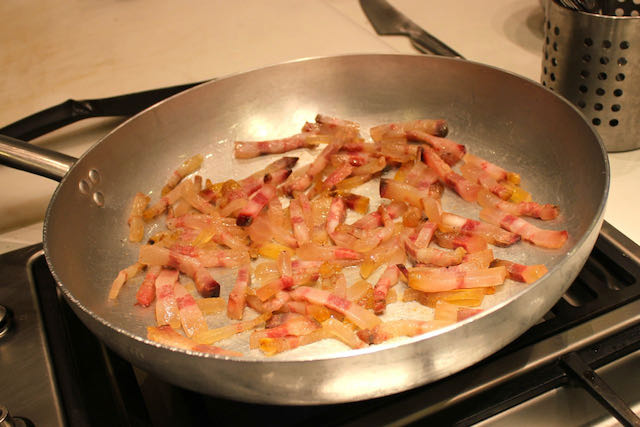 Browning of guanciale without the rind and cut into cubes. When it has formed a light crust and assumed a burnished color it's perfect.
Browning of guanciale without the rind and cut into cubes. When it has formed a light crust and assumed a burnished color it's perfect.Once the pasta water is boiling, add the pasta, and a bit of salt (not too much.)
While the pasta is cooking, beat the egg yolks in a large bowl with a fork.
Keep beating the yolks and slowly add two spoonfuls of the pasta water.
Continue beating the yolks and add one spoonful of the guanciale fat, and a bit of the ground pepper.
When the pasta is not quite cooked al dente, take out about a cup of the pasta water and set aside.
Drain the pasta.
Add it to the pan with the guanciale and remaining fat.
Mix well, adding a bit of the pasta water as needed, to create a good emulsion.
Once well blended, add this pasta mixed with guanciale to the large bowl with the beaten egg yolks.
Stir continuously and let the hot pasta blend well with the yolk mixture, so that it cooks it ever so slightly.
Keep stirring and slowly add the pecorino, blending well.
Plate the pasta, and garnish with the guanciale and black pepper that had been set aside.
And that my friends, is how we make pasta alla carbonara in Rome!
(At least, how my teacher taught me to make it!)
Best Carbonara in Rome - a Map
Click here to visit my interactive Google map showing all the places listed on this page.
It will open in a new window.
Romewise's Top Travel Resources
Ready to book your trip to Rome? Take a look at these helpful links to companies we use and trust:
- Keep your travel spending simple with the Wise card, which removes all the worry about exchange rates and high transaction fees all over the world
- Search for and book your perfect accommodation
- Our complete guide to what to pack for Rome
- The number one travel accessory, a multi-point travel adapter and voltage converter
- Browse a huge range of tours in Rome and beyond
- Experience unique tours and special access to Rome's most popular sights
- Protect yourself with comprehensive travel insurance
Within this post there are some affiliate links for products and services. For more details about our affiliate policy click here.
Get your 100% free Rome trip planner now!
Simply sign-up today for our free newsletter and get the Romewise Quick Start guide to Rome:
We are committed to respecting your data. Click for our Privacy Policy.
Comments? Questions? Suggestions?
Please come over to the private Romewise Facebook group and join in the conversation.
You will often find me there, happy to answer your questions / comments!
You will also meet other Rome lovers and experts, too.
What are you waiting for?
- Romewise Home Page
- Where to Eat
- Carbonara in Rome

